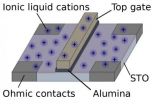(Press-News.org) A new mechanism to inhibit proteasomes, protein complexes that are a target for cancer therapy, is the topic of an article published in the journal Chemistry & Biology. The first author of the study is Daniela Trivella, researcher at the Brazilian Biosciences National Laboratory at the Brazilian Center for Research in Energy and Materials (LNBio/CNPEM).
The findings of the study, conducted with FAPESP support in partnership with researchers from the University of California in San Diego, United States, and at the Technische Universität München, in Germany, are paving the way for the development of a new generation of chemotherapy drugs that are more effective and less toxic.
"We have already developed a series of molecules based on the newly identified mechanism. Now we plan to synthesize them in partnership with CNPEM researcher Marjorie Bruder and test their potential. The goal is to optimize the proteasome inhibition effect, make the compound even more selective of tumor cells and eliminate the resistance problems found with drugs that are currently available on the market," Trivella said.
A member of the category of enzymes known as proteases, the proteasome is a protein complex responsible for several essential functions inside cells, such as eliminating harmful or non-functioning proteins and regulating the processes of apoptosis (programmed cell death), cell division and proliferation.
In 2012, the drug carfilzomib, inspired by a natural molecule called epoxomicin, was approved. Also in 2012, U.S. and Brazilian researchers isolated a natural molecule in cyanobacteria from the Caribbean called carmaphycin, whose reactive group (the portion of the molecule that interacts with the proteasome) is the same as that of carfilzomib. The molecule is known as an epoxyketone.
"Epoxyketones are very potent selective inhibitors of the proteasome because they interact with this enzyme in two stages: the first reversible and the second irreversible," Trivella explained.
To optimize its effect and find new reactive groups, researchers from the Scripps Institution of Oceanography at the University of California in San Diego developed a series of synthetic analogs with slight structural modifications.
Trivella tested these compounds during an internship in California in her post-doctoral research when she was still associated with the Chemistry Institute at the University of Campinas (Unicamp).
One of the molecules tested had an enone as a reactive group and had characteristics of carmaphycin and another natural molecule named syringolin, isolated from plant pathogens.
By investigating the reaction mechanisms of the new molecule, named carmaphycin-syringolin enone, the researcher verified that unlike syringolin, and thus like the epoxyketone, the enone interacts with the proteasome in two stages, with the second stage being irreversible.
Additionally, Trivella had observed that in the case of the enone, the second reaction occurs more slowly, increasing the duration of the reversible phase of carmaphycin-syringolin enone inhibition.
"Because the irreversible inactivation of the proteasome has toxic effects, the best window of reversibility observed for the carmaphycin-syringolin enone will potentially reduce the toxicity of this new class of proteasome inhibitors," Trivella said. "The compound would therefore present a balance between selectivity and potency."
Toxicity tests are still underway. In parallel, studies have been conducted with the help of crystallography techniques to discover exactly how the interaction between the enzyme target and the carmaphycin- syringolin enone target occurs.
"We discovered that a chemical reaction called hydroamination occurs, which had never before seen under physiological conditions. This type of reaction is frequently used by synthetic chemists in preparing substances, but normally it requires very specific temperature and pH conditions and the use of catalysts to occur. It has never been reported as a mechanism of enzyme inhibition," Trivella said.
Inspired by this new mechanism for proteasome inhibition, the LNBio group plans to synthesize and test a new series of carmaphycin-syringolin enone analogs to determine their effects on the therapeutic window (preferential death of tumor cells in relation to healthy cells) and assess whether they are also capable of reacting with proteasomes that are resistant to traditional inhibitors.
Another of Trivella's goals is to look for natural compounds in Brazilian biodiversity that could serve as inspiration for the design of other categories of proteasome inhibitors.
INFORMATION:
Discovery paves the way for a new generation of chemotherapies
In an article published in the journal Chemistry & Biology, researchers describe a new mechanism that inhibits the activity of proteasomes, protein complexes that are a target for cancer therapy
2014-09-09
ELSE PRESS RELEASES FROM THIS DATE:
Two-dimensional electron liquids
2014-09-09
Truly two-dimensional objects are rare. Even a thin piece of paper is trillions of atoms thick. When physicists do succeed in producing 2D systems, quantum interactions can lead to new phenomena and Nobel prizes. Two examples: graphene---single-atom-thick sheets of carbon atoms---has unique mechanical, electrical, and optical properties; and two-dimensional electron gases (2DEG)---planar collections of electrons supported at the interface between certain semiconductors such as gallium arsenide---allow the observation of such emergent behaviors as the quantum Hall effect ...
Rice wireless experts tap unused TV spectrum
2014-09-09
Rice University wireless researchers have found a way to make the most of the unused UHF TV spectrum by serving up fat streams of data over wireless hotspots that could stretch for miles.
In a presentation today at the Association for Computing Machinery's MobiCom 2014 conference in Maui, Hawaii, researchers from Rice's Wireless Network Group will unveil a multiuser, multiantenna transmission scheme for UHF, a portion of the radio spectrum that is traditionally reserved for television broadcasts.
"The holy grail of wireless communications is to go both fast and far," ...
Globalization threatens benefits of an African 'green revolution'
2014-09-09
A prospective "green revolution" in Africa could boost land use and carbon emissions globally, according to a study co-authored by a University of British Columbia researcher.
The term "green revolution" typically describes the use of agricultural innovations – such as the development of new seeds – to increase yields, particularly in developing countries.
Past green revolutions in Asia, Latin America and the Middle East have spared land and carbon dioxide emissions. However, in an increasingly globalized economy, an African green revolution could lead to opposite outcomes, ...
This week from AGU: Global food trade, weather forecasting, aerosol transport
2014-09-09
From AGU's blogs: Global food trade may not meet all future demand, new study indicates
As the world population continues to grow, by about 1 billion people every 12 to 14 years since the 1960s, the global food supply may not meet escalating demand – particularly for agriculturally poor countries in arid to semi-arid regions, such as Africa's Sahel, that already depend on imports for much of their food supply, according to a new study published online in the American Geophysical Union journal, Earth's Future.
From this week's Eos: Next-Generation Forecasting of High-Impact ...
Kessler Foundation multiple sclerosis researchers find role for working memory in cognitive reserve
2014-09-09
West Orange, NJ. September 9, 2014. Kessler Foundation scientists have shown that working memory may be an underlying mechanism of cognitive reserve in multiple sclerosis (MS). This finding informs the relationships between working memory, intellectual enrichment (the proxy measure for cognitive reserve) and long-term memory in this population. "Working memory mediates the relationship between intellectual enrichment and long-term memory in multiple sclerosis: An exploratory analysis of cognitive reserve" (doi: 10.1017/S1355617714000630) was published online ahead of ...
Proactive office ergonomics can increase job satisfaction and employee retention
2014-09-09
As the amount of time employees spend at their desks increases, so does musculoskeletal discomfort and other health issues associated with the office environment. Although office ergonomics training programs have been shown to improve employee well-being and productivity, in many cases training occurs only after complaints are logged. New research to be presented at the HFES 2014 Annual Meeting in Chicago demonstrates that a comprehensive and proactive workplace ergonomics program can help to prevent discomfort and injury.
Alan Hedge, coauthor of "Proactive Office Ergonomics ...
New map tool identifies patterns of racial diversity across the US
2014-09-09
University of Cincinnati geography researchers have developed a large-scale mapping technique to track a variety of demographic data across the United States, including researching populations based on gender, race and economic diversity. Details on the technique behind the new, high resolution, grid-based map of U.S. demographics developed by Anna Dmowska, a postdoctoral fellow for UC's Space Informatics Lab, and Tomasz Stepinski, the Thomas Jefferson Chair Professor of Space Exploration at UC, are published in this month's issue of Applied Geography. The map can also ...
Gambling is just plain fun for those players who are in control
2014-09-09
People who are in control of their gambling habits play for fun and like the idea of possibly winning big. They set limits on how much money and time they can spend, and they are likely to gamble on the internet. But gambling is just one of several leisure activities these players undertake. In contrast, gambling is a form of escapism for problem players and often their only social activity, say Richard Wood of GamRes Ltd. in Canada, and Mark Griffiths of Nottingham Trent University in the UK. The results appear in Springer's Journal of Gambling Studies.
Their study is ...
1 in 5 young men unable to purchase emergency contraception
2014-09-09
September 9, 2014 -- Male shoppers in search of emergency contraception do not always have an easy time making these purchases and may be turned away at their local pharmacies. A "mystery shopper" survey conducted in New York City by researchers at Columbia University's Mailman School of Public Health and Columbia University Medical Center showed that males had a 20 percent likelihood of not being able to purchase emergency contraception. Nearly three-quarters of the pharmacies in the study created barriers for the males to get the contraception. This is the first research ...
Sickle cell patients who experience discrimination miss out on treatment
2014-09-09
Experiencing discrimination because of their race or health condition can influence just how much trust people put into the health profession. In fact, having these experiences was associated with a 53-percent increase in the chances that someone suffering from sickle cell disease will not follow their doctors' orders, says Carlton Haywood Jr. of the Berman Institute of Bioethics and the Johns Hopkins School of Medicine in the US. Haywood led a study appearing in The Journal of General Internal Medicine, published by Springer, into the experiences of how patients who suffer ...
LAST 30 PRESS RELEASES:
Collaborative study uncovers unknown causes of blindness
Inflammatory immune cells predict survival, relapse in multiple myeloma
New test shows which antibiotics actually work
Most Alzheimer’s cases linked to variants in a single gene
Finding the genome's blind spot
The secret room a giant virus creates inside its host amoeba
World’s vast plant knowledge not being fully exploited to tackle biodiversity and climate challenges, warn researchers
New study explains the link between long-term diabetes and vascular damage
Ocean temperatures reached another record high in 2025
Dynamically reconfigurable topological routing in nonlinear photonic systems
Crystallographic engineering enables fast low‑temperature ion transport of TiNb2O7 for cold‑region lithium‑ion batteries
Ultrafast sulfur redox dynamics enabled by a PPy@N‑TiO2 Z‑scheme heterojunction photoelectrode for photo‑assisted lithium–sulfur batteries
Optimized biochar use could cut China’s cropland nitrous oxide emissions by up to half
Neural progesterone receptors link ovulation and sexual receptivity in medaka
A new Japanese study investigates how tariff policies influence long-run economic growth
Mental trauma succeeds 1 in 7 dog related injuries, claims data suggest
Breastfeeding may lower mums’ later life depression/anxiety risks for up to 10 years after pregnancy
Study finds more than a quarter of adults worldwide could benefit from GLP-1 medications for weight loss
Hobbies don’t just improve personal lives, they can boost workplace creativity too
Study shows federal safety metric inappropriately penalizes hospitals for lifesaving stroke procedures
Improving sleep isn’t enough: researchers highlight daytime function as key to assessing insomnia treatments
Rice Brain Institute awards first seed grants to jump-start collaborative brain health research
Personalizing cancer treatments significantly improve outcome success
UW researchers analyzed which anthologized writers and books get checked out the most from Seattle Public Library
Study finds food waste compost less effective than potting mix alone
UCLA receives $7.3 million for wide-ranging cannabis research
Why this little-known birth control option deserves more attention
Johns Hopkins-led team creates first map of nerve circuitry in bone, identifies key signals for bone repair
UC Irvine astronomers spot largest known stream of super-heated gas in the universe
Research shows how immune system reacts to pig kidney transplants in living patients
[Press-News.org] Discovery paves the way for a new generation of chemotherapiesIn an article published in the journal Chemistry & Biology, researchers describe a new mechanism that inhibits the activity of proteasomes, protein complexes that are a target for cancer therapy



